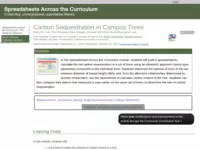Carbon Sequestration in Campus Trees
https://serc.carleton.edu/sp/ssac_home/general/examples/14323.html
https://serc.carleton.edu/sp/ssac_home/general/examples/14323.html
Robert S. Cole, Spreadsheets Across the Curruculum; Washington Center; Science Education Resource Center (SERC)
In this activity, students use a spreadsheet to calculate the net carbon sequestration in a set of trees; they will utilize an allometric approach based upon parameters measured on the individual trees. They determine the species of trees in the set, measure trunk diameter at a particular height, and use the spreadsheet to calculate carbon content of the tree using forestry research data.
Activity takes about a one-hour class period with subsequent homework or computer time.
Learn more about Teaching Climate Literacy and Energy Awareness»Grade Level
Regional Focus
Online Readiness
Topics
Climate Literacy
This Activity builds on the following concepts of Climate Literacy.
Click a topic below for supporting information, teaching ideas, and sample activities.
- Humans can take action
- Climate is complex
- Life affects climate; climate affects life
- Our understanding of climate
Excellence in Environmental Education Guidelines
1. Questioning, Analysis and Interpretation Skills:G) Drawing conclusions and developing explanations
Other materials addressing:
G) Drawing conclusions and developing explanations.
Other materials addressing:
G) Drawing conclusions and developing explanations.
1. Questioning, Analysis and Interpretation Skills:B) Designing investigations
Other materials addressing:
B) Designing investigations.
Other materials addressing:
B) Designing investigations.
1. Questioning, Analysis and Interpretation Skills:E) Organizing information
Other materials addressing:
E) Organizing information.
Other materials addressing:
E) Organizing information.
2. Knowledge of Environmental Processes and Systems:2.1 The Earth as a Physical System:A) Processes that shape the Earth
Other materials addressing:
A) Processes that shape the Earth.
Other materials addressing:
A) Processes that shape the Earth.
2. Knowledge of Environmental Processes and Systems:2.1 The Earth as a Physical System:B) Changes in matter
Other materials addressing:
B) Changes in matter.
Other materials addressing:
B) Changes in matter.
2. Knowledge of Environmental Processes and Systems:2.2 The Living Environment:D) Flow of matter and energy
Other materials addressing:
D) Flow of matter and energy.
Other materials addressing:
D) Flow of matter and energy.
2. Knowledge of Environmental Processes and Systems:2.4 Environment and Society:D) Technology
Other materials addressing:
D) Technology.
Other materials addressing:
D) Technology.
Notes From Our Reviewers
The CLEAN collection is hand-picked and rigorously reviewed for scientific accuracy and classroom effectiveness.
Read what our review team had to say about this resource below or learn more about
how CLEAN reviews teaching materials
Teaching Tips | Science | Pedagogy |
Technical Details
Teaching Tips
- If this activity is being done for the first time, it will serve as a baseline for future, follow-up projects by other students.
- This module is best used when data on a given set of trees are available from prior years, but establishing a solid baseline is important for all scientific measurements.
- Assuming that data from field measurements are available to students, this module could be used as a homework exercise, or as a lab exercise. The module is also useful in teaching about how ecologists and biologists use allometric relationships as well as teaching about the power function.
About the Content
- The resource guides students through the process of estimating tree biomass from measurements of tree diameter at breast height and the use of the allometric relationship between growth and size of one portion of a tree and the growth and size of the whole tree.
- Instructor can assign this as is (using the example data set to teach the process) or can add enrichment, including a campus tree survey in collaboration with groundskeeping.
- Opportunity to stress the global seasonal flux of CO2 due to plants in the Northern Hemisphere absorbing CO2 from the atmosphere through photosynthesis in the spring and summer and releasing carbon through decay into the atmosphere in the fall and winter.
- Comments from expert scientist: It makes users think about the age of the trees and how their uptake compares to our emissions. It may give a simplistic idea of carbon sequestration without considering the drawbacks of large forest stands. Having a lot of trees around may be good for carbon sequestration, but on watersheds trees crowd out grasses which are much better for precipitation infiltration than a thick forest.
About the Pedagogy
- This module consists of a PowerPoint presentation with background materials and instructions on how to recreate the embedded images of spreadsheets. The students develop the needed cell formulas and complete the spreadsheet to estimate the amount of carbon stored in the tree's biomass.
- Students build quantitative skills and skills working with Excel spreadsheets.
- Manipulating spreadsheet models may be engaging for some students.
- If the instructor chooses to do a tree inventory on campus, students may be more engaged in the activity, as it is more applicable to their lives.
- Little teacher support, other than guidance, is required for this exercise.
- This resource engages students in using scientific data.
See other data-rich activities








